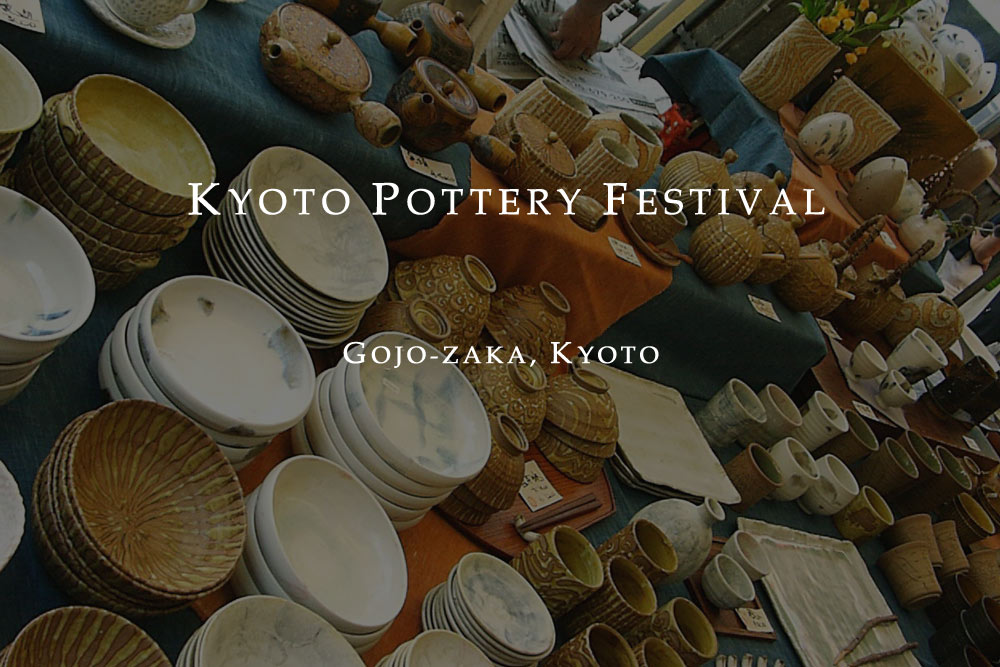Imagine the sense of exhilaration children feel when they walk into a candy store filled wall-to-wall with scrumptious goodies of all kinds. For anyone who appreciates Japanese ceramics, be it the casual enthusiast or the astute collector, the sensation of walking through the Gojōzaka Pottery Fair in Kyoto, Japan is strikingly similar. Stands set up by ceramic shops and local artists (nearly 500 in all) extend five blocks along both sides of Gojō street, all offering visitors an endless variety of green tea cups, saké ware, plates, tea ceremony bowls, vases and more - the kind of delectable pottery and porcelain that has made Kyoto one of Japan's major ceramic centers.
The red and white curtains on the front of these stands, hung only during auspicious occasions, signal to visitors that this is going to be a good time.
And it is. Cheerful vendors greet everyone with a loud "irrashaimase!" (welcome!), bargain hunters hurry by with bags filled with things for their cupboard, and treasure hunters carefully scan the lower shelves and corners for those rare pieces that beg to be added to their collection.
For centuries, the kilns of the Gojō district in eastern Kyoto have fired some of the finest pottery and porcelain in Japan. New environmental regulations in the 1980s, though, forced all wood-burning kilns to relocate outside of the city's boundaries, and one of the last to close was the community kiln used by the legendary mingei potter Kawai Kanjirō. Although the source was now further away, the shops associated with these kilns continue to thrive along this historic street and play host to the annual event.
The Gojōzaka pottery fair serves as a way for shops to get rid of unsold inventory and to make room for stock from the next season's firing. Accordingly, the majority of items is marked down, and negotiating a slightly deeper discount is not at all uncommon.
At other stands, you'll find pottery from other parts of Japan like Shiga, Tamba, and Hagi to name a few. Neighbors sometimes make interesting companions, with colorful ceramic kitsch sharing space with the unadorned beauty of Bizen-yaki from Okayama Prefecture.
A large number of stalls are set up by young, local artists who use the festival as a venue to introduce their work to a larger audience. This is quite beneficial to up-and-coming potters who lack enough reputation to display their work at prestigious department store galleries like Kyoto Takashimaya or Daimaru. It's also a good way for buyers to find quality, contemporary pieces at reasonable prices.
Who knows? That piece you pick up today may be worth a fortune later - even Living National Treasures have to start somewhere.
To truly take in the whole festival, a good hour is needed to scan up and down both sides of Gojōzaka street. When the wheat has separated from the chaff, another hour is needed to return to those stalls that had something that caught your eye.
In the end, no one leaves the Gojōzaka Pottery Fair disappointed. As one gleeful visitor from abroad was heard saying, "This is like nothing I've ever seen! I wish I had brought another suitcase so I could bring all of this home."
Tips for First-Timers:
Go early
According to the Kiyomizu-yaki Ceramics Association, nearly 50,000 visitors attend the festival during the four days that it is held. The best finds are picked over quickly, so the earlier the better.
Don't forget your uchiwa
First-time visitors to the festival should be warned - it's hot and often rainy. The festival is held at the first week of August when afternoon temperatures in Kyoto can reach 39°C (100°F) or more.
Make sure to bring your sunscreen, plenty of bottled water, and an uchiwa (fan).
Bring a bento
Several stands sell canned drinks and festival food, but it's recommended that you bring your own lunch. There are few restaurants and one convenience store along Gojōzaka street, so bringing a bento (lunch box) is highly recommended.
For Visitors
The Gojōzaka Pottery Fair is held every year from August 7th to 10th (4 days).
Stalls are set up at 9:00 AM and stay open until 7:00 PM or later.
The best access is from Kiyomizu-Gojō Station on the Keihan Line.


